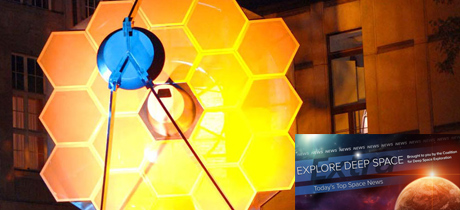In Today’s Deep Space Extra… New supplies, launched Monday, reached the International Space Station astronauts early Thursday. Experts confront an imaging issue with a new NOAA weather satellite. NASA Administrator Jim Bridenstine tells Senate panel he’s committed to overcoming challenges with the James Webb Space Telescope (JWST).
Human Space Exploration
Space Station accepts special delivery from Virginia
Coalition Member in the News – Orbital ATK
Associated Press via New York Times (5/24): Orbital ATK’s ninth NASA contracted Cygnus cargo capsule reached the International Space Station early Thursday, three days after its launch atop an Antares rocket from NASA’s Wallops Island Flight Facility on Virginia’s Eastern Shore. NASA astronauts Scott Tingle and Ricky Arnold used the Station’s 58 foot long Canadian robot arm to latch onto Cygnus and its 7,400 pound cargo of crew supplies and science experiments at 5:26 a.m., EDT. Operations to berth the capsule for a stay expected to last until mid-July were underway.
Space Science
NOAA’s new GOES-17 weather satellite has degraded vision at night
Spaceflightnow.com (5/23): Launched March 1, NOAA’s GOES-17 weather satellite is positioned in geosynchronous orbit over the Pacific to monitor important weather and environmental trends over the western U.S. and Pacific. Wednesday, NOAA announced that the high tech satellite is dealing with a malfunction of its primary imaging instrument. A companion high altitude weather satellite, GOES-16, is watching over the Eastern U.S. and Atlantic following a November launch. While additional troubleshooting continue, NOAA is hopeful they can develop a correction of mitigation. Other satellites with the same imager are working as hoped.
Drilling success: Curiosity is collecting Mars rocks
NASA/Jet Propulsion Laboratory (5/23): Thanks to a new drilling technique, NASA’s Mars Curiosity Rover is once again probing rocks at Gale Crater on Mars. A malfunction brought drilling by Curiosity in order to assess past environmental conditions on Mars to a halt in late 2016. Earlier this month, NASA commanded Curiosity to try out the new technique, permitting the rover to drill two inches into a rock called Duluth. There’s more to come for Curiosity, which touched down on the Red Planet in August 2012.
Bridenstine: NASA may ask Congress for more money for James Webb Space Telescope (JWST)
Coalition Member in the News – Northrop Grumman
Houston Chronicle.com (5/23): New NASA Administrator Jim Bridenstine promised to support the launch of the technically challenged James Webb Space Telescope (JWST). Earlier this year, NASA reset the launch of the JWST from the spring of 2019 to May of 2020 in order to deal with hardware integration and pre-launch test issues. The difficulties threaten to push the observatory’s development cost total over an $8 billion cap established by Congress in 2011. By the end of June, an independent review of the project should reveal whether the telescope will exceed the cap and require Congress to re-authorize its five to ten year mission to study the earliest galaxies and look for evidence of bio markers in the atmospheres of extra solar planets. Bridenstine appeared Wednesday before the U.S. Senate Appropriations Commerce, Justice and Science Subcommittee to discuss NASA’s proposed 2019 budget.
Planetary scientists suggest that Pluto was put together from a billion comets
GeekWire.com (5/23): Data gathered by NASA’s New Horizons mission to Pluto and the European Space Agency’s Rosetta mission to the comet 67P/Churyumov-Gerasimenko suggest distant Pluto formed from an aggregation of comets, according to a study by scientists from the Southwest Research Institute and published in the journal Icarus.
Other News
‘Impossible’ EmDrive space thruster may really be impossible
Space.com (5/23): EmDrive, a theorized space propulsion system undergoing NASA scrutiny and using microwaves rather than chemical propulsion, continues to puzzle as well as intrigue experts.
SpaceX achievements generate growing interest in reusable launchers
Space News (5/23): Rocket reuse is receiving growing acceptance within the aerospace industry, say participants in the Space Tech Expo conference underway in Pasadena, California, this week. SpaceX now claims a dozen re-flown Falcon 9 first stage boosters. Blue Origin has demonstrated the concept with its suborbital New Shepard and intends to do as much with the first stage of its New Glenn orbital rocket. European space agencies and commercial companies that once expressed skepticism of the concept are now showing more interest.

